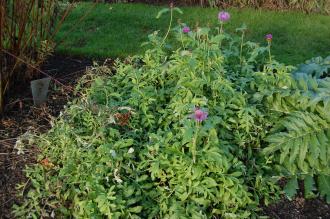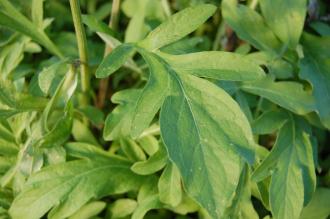
Centaurea dealbata (16/11/2013, Kew Gardens, London)
Position: Full sun
Flowering period: Summer
Soil: Moist, well drained
Eventual Height: 75cm
Eventual Spread: 60cm
Hardiness: 4a, 4b, 5a, 5b, 6a, 6b, 7a, 7b, 8a, 8b, 9a
Family: Asteraceae
Centaurea dealbata is a deciduous herbaceous perennial with a clump forming habit. Its mid green leaves are pinnately deeply lobed with entire margins, up to 40cm long and 15cm broad. Its pink/ purple flowers are solitary, composite and up to 5cm across. Its fruit are achenes.

Centaurea dealbata Flower (16/11/2013, Kew Gardens, London)
Centaurea dealbata, commonly known as Persian Cornflower or Whitewash Flower, is native to the Caucasus Mountains.
The etymological root of the binomial name Centaurea is named after the Centaur (a Greek mythological creature), a name given to the plant commonly known as Centaury. Dealbata is derived from the Latin meaning ‘whitened, whitewashed or plastered’.
The landscape architect may find Centaurea dealbata useful as part of a mixed herbaceous planting scheme. Once established this perennial is drought tolerant.
Ecologically, Centaurea dealbata flowers are very attrative to polinating insects.

Centaurea dealbata Leaf (16/11/2013, Kew Gardens, London)
Centaurea dealbata prefers moist, fertile, well-drained soils. It tolerates most pH of soil. This plant dislikes wet soils.
Centaurea dealbata requires little maintenance. Plants may be cut back hard in mid summer to maintain a tidy compact habit.

